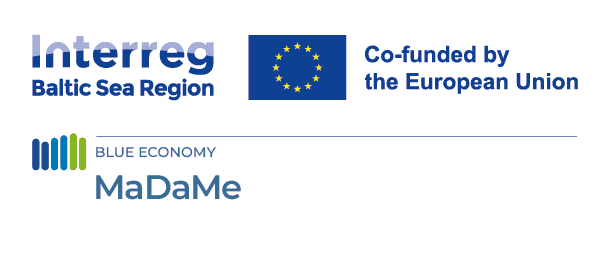
Maritime Connectivity Platform – secure and reliable information exchange for maritime stakeholders
23 April 2025
Maritime Connectivity Platform (MCP) is an essential part in future information exchange process for the digital maritime services. In MaDaMe project the MCP development is done in parallel with the development of the new digital e-navigation services. Many people have heard of the MCP concept, but it may not be so well known what is “under the bonnet” of the MCP and what is the status of the development work. Let’s ask the MCP experts Thomas Christensen from Digital Maritime Consultancy (DMC) and Juho Pitkänen from Fintraffic VTS!
What is MCP?
Thomas Christensen describes the MCP as follows: “The Maritime Connectivity Platform is a decentralized platform designed to facilitate secure and reliable information exchange within the maritime domain and beyond. MCP has been developed to support digital communication between ships and shore-based entities. However, the maritime world isn’t isolated; it needs to exchange information also with other domains, such as other modes of transport. The information exchanged can vary widely, from public information provided by authorities, such as navigational warnings, to private, confidential data between a vessel and the shipowner”
What are the components and functionalities provided by MCP?
Maritime information exchange is transitioning from basic radio communication like Navtex to more advanced digital communications. These new ways to communicate are often based on internet technologies. That raises a range of new requirements that MCP addresses. Juho Pitkänen lists us the most important requirements:
- Provision of trusted identities: Service providers and service users should be authenticated. This is provided by the MCP’s Maritime Identity Registry (MIR), which holds these identities and associated digital certificates.
- Service discoverability: Being on the internet means potential access to vast amounts of data and services. A trustworthy and reliable means of locating the required services is needed. The Maritime Service Registry (MSR) component of the MCP is providing this functionality, as a kind of yellow pages for maritime services.
- Messaging service: The Maritime Messaging Service (MMS) component of MCP provides the capability of addressed messaging and multicasting to any entity over both IP-based and non-IP-based physical communication carriers.
MCP being a decentralized system, how will the different MCP instances work together?
Explaining the decentralized system in a nutshell is a tough job even for a seasoned expert like Juho Pitkänen, but after a little thought, he can provide a simple and clear description:
“MCP as a decentralized system relies on self-organization and coordination among the MCP instances. Each MCP instance operates independently but follows the same standards and protocols, allowing them to work together harmoniously.
The decentralized nature of MCP allows global service discovery. When a vessel searches for a service, such as digital VTS service, the request is processed through the interconnected MCP ecosystem. The service registry component of MCP enables the vessel to locate the required service across all MCP instances, ensuring comprehensive coverage and accessibility.
The Maritime Identity Registry ensures that information exchanged within the whole MCP ecosystem is secure and reliable. MCP MIR identity registers will provide a framework for trust management across different MCP instances, ensuring that all interactions within the ecosystem are trustworthy.”
How can MCP support the mariners to utilize digital navigation services in practice?
Thomas Christensen illustrates the MCP concept through an example:” Imagine a vessel approaching Danish waters on its way into the Baltic Sea. The vessel has the next generation S-100 compatible ECDIS, which can display information from new e-Navigation services like Navigational warnings, AtoN faults or digital weather information. MCP helps vessel to find these services from various service providers such as the Danish authorities. Besides service discovery, MCP helps vessels to validate the identity of service provider and authenticity of the data. MCP ensures the seamless and secure information exchange between vessel and shore-based entities.”
What is the status of the MCP standardization work?
Juho Pitkänen begins by talking about the actors involved in the standardization work: “International standardization organizations in charge of the MCP related standards are International Organization for Marine Aids to Navigation (IALA) and Radio Technical Commission for Maritime Services (RTCM). MaDaMe project partners play a significant part in the standardization work in these organizations and work actively to create global MCP standards.”
Thomas Christensen continues by summarizing the standardization status of the four components of MCP, each at different levels of maturity regarding standardization:
- Maritime Identity Registry: Standardized as IALA Guideline 1183 ‘Provision of MCP identities’.
- Maritime Service Registry: A new IALA standard was submitted for approval from the latest IALA DTEC committee meeting. Once adopted by the IALA council, it will be published as an official IALA guideline.
- Maritime Messaging Service: Recently adopted as RTCM standard 13900.0.
- Decentralized Trust System: Still in a conceptual state, likely to become an IALA guideline within the next year or two.
What is the status of the development work in Finland and Denmark?
Finland has been one of the early adopters of MCP concept. Fintraffic VTS is currently building its own MCP instance based on international standards. According to Juho Pitkänen, this initiative is part of Finland’s broader strategy to enhance maritime safety and efficiency through digitalization.
“By developing its own MCP instance, Fintraffic VTS aims to provide a robust platform for secure and efficient information exchange between ships and governmental shore-side organizations. We have been following the pace of MCP standardization and started the implementation of our MIR at the same time as IALA was preparing its guideline for provision of maritime identities. Now, thanks to MaDaMe project, Fintraffic VTS has been able to start also developing MSR. This work has, for its part, contributed to the development of IALA’s maritime service registry guideline, which has just been finalized. Juho describes the development work in more detail.
Thomas Christensen summarizes the MCP development in Denmark: “In Denmark, a commercial MCP is being established by DMC in collaboration with their Korean partner AIVeNautics. The MCP instance will comprise all three components of the MCP, including MMS. The DMC’s Messaging Service utilizes MMS router network in several countries in North America, Europe, and Asia. The plan is to get MCP instance operational and endorsed by the MCP consortium in the third quarter of 2025.”
The MCP ecosystem is continuously evolving, with improvements and updated features based on global feedback and technological advancements. This ensures that the MCP concept remains cutting-edge and responsive to user needs. These developments highlight the transformative potential of MCP in the maritime domain, paving the way for a safer, more efficient, and interconnected maritime future.





